Table of Contents
13
EMERGING TRENDS IN CCT
Objectives
After completing this Chapter, the student will be able to:
- appreciate and describe the emerging trends in the field of computer software, computer storage and processing and types of storage devices,
- understand and interpret the kind of technology that will drive the next generation computer controlled devices and
- explain Nanotechnology.
“Logic will get you from A to B. Imagination will take you everywhere.”
Albert Einstein
Introduction
By now you have come out of the conventional ideas of a computer whether in regard to its physical appearance or its functionalities and seen the multifarious fields of activities in which the principle is operative irrespective of the physical appearances of the device. With electronic devices becoming ubiquitous, it is important to know and understand the latest trends and anticipate what is coming in the near future. It is a process of continuous evolution, constantly updating and improving in efficiency and functionality.
Not only the computer system has become faster, compact and inexpensive but associated communication system has also become affordable, reliable and user friendly.
The processing speed of the computers is getting nearly doubled and every year a new processor is released. Still research is going on to look for different avenues for improving computer processing using improved materials, nanotechnology, multi core processors, quantum computers, etc.
The emerging trends in the field of CCT is also focussed on research and development on energy efficient systems, wireless and optical communication, biometric, security system, multimedia and on demand software. This chapter will broadly focus on the following fields.
1) Hardware
2) Semiconductor
3) Communication system
4) Quantum Computing
5) Software
6) Nanotechnology
13.1 EMERGING TRENDS IN HARDWARE
The advancements in CCT are bringing us devices in miniaturised forms like digital cameras, cell phones, iPods and flash disks etc.
13.1.1 Storage Devices
In computer storage, the trend is towards increased capacity in terms of memory and processing speed on one side and reduction in size and cost on the other side.
Today, the type of data is no more merely text documents, it is in multimedia form which require more memory space for storage. The research in this field led to development of storage devices like iPod, Pen-drives, flash disks, DVDs which have capacities to store data upto a maximum of 50GB as on today. An iPod can store music, videos, documents, pictures and games. Their storage capacity varies from 1GB to 80GB.
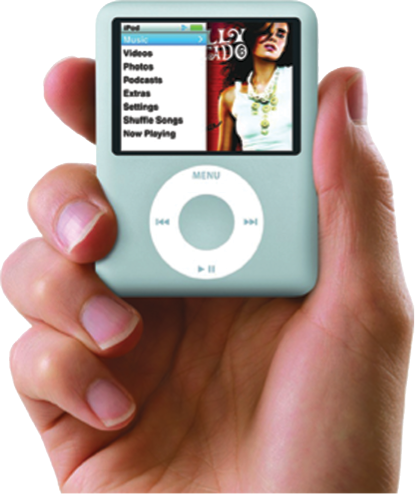
Figure 13.1 : An iPod
Hard Disk
We have seen tremendous growth in the hard disk capacities over years which is expected to grow even further. Hard disk drives have become faster, with faster seek time, larger cache sizes, and higher interface speeds. One of the most important parameters for improving performance is the higher spindle speed, effectively improving the internal data rate and reducing latency. Nanotechnology has played an active part in reducing the size of hard disks and in the increase of their capacities.
Hybrid Hard Disk Drive (HHDD) is a newer technology where the conventional disk drive is combined with non-volatile flash memory, of typically 128MB or more to cache data during normal use. The data is initially stored in non-volatile memory before permanently storing it in the hard disk. Enterprise HDDs are specifically designed for mission-critical applications such as core servers and large-scale storage systems. The first hybrid hard disk drives were 2.5 inch drives for notebooks.
Whole Disk Encryption/Full Disk Encryption (FDE) is a new technology (hardware or software) where data is encrypted before storage. This prevents unauthorised access or retrieval of data.
Micro Electro Mechanical Systems [MEMS]-based storage is a new technology being developed as a new age storage media due to its attractive features such as small size, shock resistance, and low-power consumption. MEMS-based storage is anticipated to be widely used for mobile consumer electronics.

Redundant Array of Inexpensive Disks (RAID)
Redundant Array of Inexpensive Disks (RAID) is a way of storing the same data in different places redundantly on multiple hard disks. This helps to restore the copy of the data even if one of the disks fails. The technology allows replacing the faulty disk without shutting down the system.
Emerging trends in RAID allows us to save expensive rack space and reduce co-location costs.
3-D Optical Data Storage
3D optical data storage is a new technology where data is stored in multiple layers in the optical disc. Laser beam is used for reading and writing the data from/to an optical disc. The disc contains many layers of data, each at a different depth in the media and each consisting of a DVD-like spiral track (Figure 13.3).

Holographic Memory
Holographic Memory is quite similar to 3-D Optical Data Storage. Here data is recorded through full depth of the media instead of only on the surface. Thus it can record and read millions of bytes of data with a flash of light. High density Optical disc is an example of holographic storage.
Network Storage
Network storage allows consolidating all data spread over various parts of the organisation into one location, from where it is accessed by multiple applications across the network simultaneously. There are two technologies which are being used - SAN and NAS.
Storage Area Network (SAN)
Storage Area Network (SAN) is an architecture where the different secondary storage devices like hard disk arrays, tape drive etc. are attached to remote computer storage devices and all the servers are connected to the SAN through the SAN switch and the servers can access data as local disk drives. The remote storage devices are shared by multiple servers simultaneously (Figure 13.4).

Figure 13.4 : Storage Area Network (SAN)
Network Attached Storage (NAS)
Network Attached Storage (NAS) uses remote computer with storage devices which are connected through TCP/IP network as shown in Figure 13.5. It uses file-based protocols such as Network File System or Common Internet File System (CIFS). All the servers and storage devices are connected through LAN or WAN.
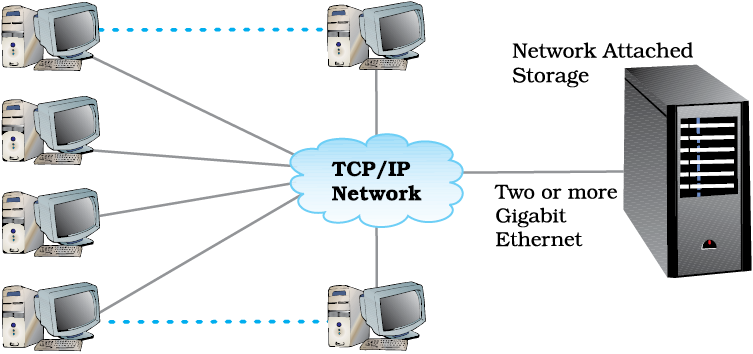
Figure 13.5 : Network Attached Storage (NAS)
Online storage options
There are several companies which provide online storage to enable the user to store data on their servers. These services are offered to the Internet users freely but with limited storage. Network and distributed file systems, and Internet-based data centres are some examples of online storage implementations.
Peripheral/Interface
Universal Serial Bus (USB) is used for connecting peripherals to PC. The popularity of USB is due to its low cost, ease-of-use, and small connector size. It is easy to add USB support to any peripheral. Latest USB trends are discussed in the following section.
USB in embedded systems
USB has a vast number of applications in embedded systems like cell phones, PDAs, digital cameras, printers, and set top boxes.
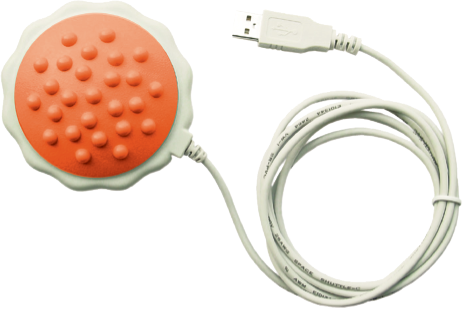
Figure13.6 : USB embedded massage ball
Wireless USB
Wireless USB allows low-speed devices to connect without wire, but appear to the host as if they are connected over wired USB. Wireless USB (Figure 13.7) is an ideal solution for simple cable replacement applications.

Figure 13.7 : Wireless USB
13.1.2 MICROPROCESSOR
A microprocessor is a multipurpose programmable logic device that reads binary instructions from a storage device called memory, accepts binary data as input and processes data according to those instructions and provides results as output.
The conventional basic function of a single microprocessor has been changed to more complex microprocessor architecture. Instead of single microprocessor, packages of multiple microchips and processors are released which fulfil and meet the performance requirement for a computing system for a particular application. These packages are simply installed into standard interface on motherboards.
Similarly the Core 2 processor refers to two separate dual-core dies (CPUs) – next to each other – in one quad-core package.
Xeon processors refer to many families of Intel’s multiprocessing CPUs – for dual-processor (DP) and multi-processor (MP) configuration on a single motherboard. They are used for server and workstation computers. It has been maintained over several generations of x86 and x86-64 processors. The Xeon CPUs generally have more cache than their desktop counterparts, in addition to multiprocessing capabilities.
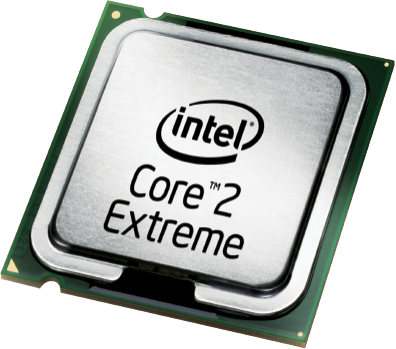
Figure 13.8 : Intel dual core 2
13.2 EMERGING TRENDS IN SEMICONDUCTORS
Use of innovative technologies like Silicon-On-Insulator (SOI), Complementary Metal-Oxide-Semiconductor (CMOS), capacitor-less memory, Micro-Optic-Electro-Mechanical-System (MOEMS), III-V compound materials-on-insulator and others have improved the performance and also reduced the size of consumer electronic devices.
Apart from the development of innovative designs, researchers are also exploring materials other than Silicon to develop high speed electronic chips. One such example is Graphene, which is a form of pure carbon where – a single layer of carbon atoms are arranged in a honeycomb lattice. It could allow electrons to process information and produce radio transmissions 10 times better than silicon-based devices. Usage of Graphene will produce faster and more powerful cell phones, computers and other electronic devices, since the mobility of electrons is more than any existing semiconductor materials, like Silicon, GaAs and carbon nanotubes.
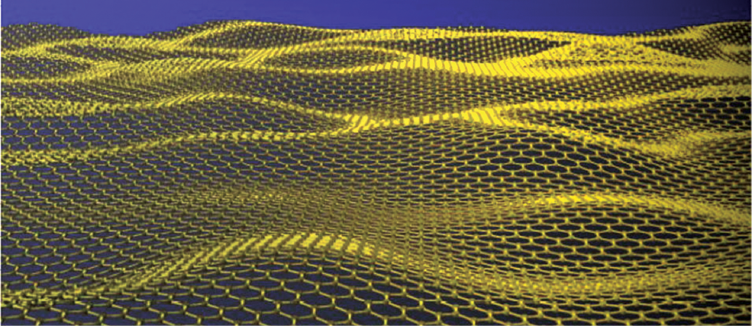
Figure 13.9 : Graphene
Another key area where extensive research is being carried out is the development of application processor of 3D graphics and RAM memories. Research is going on to develop multiple semiconductors into single packages.
13.3 EMERGING TRENDS IN COMMUNICATION SYSTEMS
In communication the trend is to develop integrated multimedia systems such as VoIP (Voice over Internet Protocol), IP TV, Video Conferencing, Video on Demand etc. The emphasis is to upgrade the legacy communication system that can support multimedia applications.
Apart from these, technologies are being developed to provide cost effective networking solutions and to extend the network to end user premises. Examples in this area include multi service broadband network, DTH (Direct-To-Home), Fiber-to-home etc.
13.4 EMERGING TRENDS IN Quantum COMPUTING
Since the invention of Optical fiber and Lasers, use of light in computers and communication systems is being increasingly explored. Quantum computing means using light instead of electricity for data storage and transmission. Optical communication system had brought revolution in the transmission industry and communication network.
Efforts are being made to develop Silicon Lasers to replace silicon electronic chips. This would not only improve the speed, but also give energy efficient devices. Research and development is going on to design optoelectronic devices using optical component with silicon.
The research in the field of photo-electronics would help in developing cost effective next generation devices that would use both electrons and photons to process information. The development of photo-electronic devices is being done with collaborative effort of engineers and scientists from various fields as optics, chemistry, electronics and material science.
Apart from optical communication systems, optical devices such as optical mouse, optical hard disk, optical sensors etc. have been/are being developed to meet consumer electronic sectors.
13.5 EMERGING TRENDS IN SOFTWARE
Computer software and hardware go hand in hand and improvements in one lead to improvement in another. The design of the computer software has seen a paradigm shift – from structured programming to object oriented programming. Open source software is gaining popularity for its readiness to be extended by anyone and applied on any device. Moreover, they are freely available as they are developed by a community of developers.
Initially, software was produced largely by academics and corporate researchers working in collaboration and was not itself seen as a commodity. Variety of software ranging from that used in a mobile phone to the software for designing an aeroplane are available these days.
13.5.1 Operating System
The Operating Systems which do not provide sufficient flexibility to the application developers like UNIX are beaconing obsolete. The latest trend is to design and develop customised application specific Operating Systems which can detect hardware failure and have auto-recovery features.
13.5.2 Application Software
Software development has become a more systematic process where a great emphasis is laid on finding out the user requirement, preparing a process model, demonstrating an early version to its customers (prototyping) and on trying to ensure that the software is free of errors. Moreover, an incremental software development process is followed where a project proceeds in small and manageable steps.
An important trend in software is the use of component driven software development. Here, instead of writing programs from scratch over and over again, software developers can select components from comprehensive libraries of reliable and well documented software components and combine them together to carry out the required purpose.
The latest market trend is to develop Commercial-Off-The-Self (COTS) packages which can meet upto 50% system functionalities and can be used to develop customised applications (which meet the rest of the user requirements). The applications are developed by using existing reusable components of COTS packages and combining them with the new requirement. Such components are required to be useful, easy to use and interoperable which can work across networks, the Internet and with web browsers. Many such packages such as GIS, Simulators, CAD/CAM, SAP etc. are available in the market and applications are being developed using these COTS packages.
There are enormous number of application software catering to our needs. The capabilities are increasing day by day as per needs. Grossly we can categorise them according to their use as :
- Educational and communication software
- Design, media and simulation software
- Office automation and process mangement software
- Control and analysis software
Educational and Communication Software
More and more educational software on topics simple to complex, ranging from learning alphabet to experiments on genetics are being developed for learning purposes. In this category, the Edutainment Software are getting more and more popular because the presentations are done in multimedia form and have educational value in entertaining way. Thus learning becomes a stress free and enjoyable exercise to the user. A few indigenous multimedia software are Milestone in Genetics, Locus, Ray Optics, etc.
The Learning Management System (LMS) are software which manage user learning interventions. Most of the LMSs are web-based and go far beyond conventional training records management and reporting (e.g. ATuTor, Moodle, Brihaspati-II, Enrich). They cater to the needs of the user in training workflow (e.g. user notification, manager approval, waitlist management), the provision of on-line learning, on-line assessment, collaborative learning (e.g. application sharing, discussion threads), training resource management like instructors, facilities, equipment. They are used by regulated industries and also educational institutions. They are based on a variety of platforms like Java/J2EE, .net and PHP and use a database as backend.
Design, Media and Simulation Software
The advancements in CCT have not only resulted in higher processing speed, increased storage capacity and reduced price but also has brought out variety of high resolution output devices capable of displaying many millions of colours and shades and serving to a particular purpose.
The Media development software caters to the needs of people who generate print and electronic media, usually in educational and commercial settings. CatGrab (a digital camera software) for Windows, Track ‘n share your GPS adventures!, Ashampoo 3D CAD Architecture are some media development softwares used.
Using Image organiser one can resize, tag digital images, organise pictures into albums by drag and drop, can export the pictures for external use (by e-mail or print). Some examples are Falco Icon Studio 4.8, Tif Joiner etc.
Graphic art software are primarily used for graphic design, multimedia development, specialised image development, general image editing and accessing graphic files. Ashampoo Photo Optimiser FREE, Ashampoo Photo Commander, ACX Diashow XL are such kind of software.
Image editing software allows us to manipulate and edit scanned images e.g. FastStone image viewer, Falco Icon Studio 4.8, Adobe Photoshop, PhotoPlusSE. Here by using Adobe Photoshop, a coloured picture (Figure 13.11) has been developed from black and white picture (Figure 13.10).
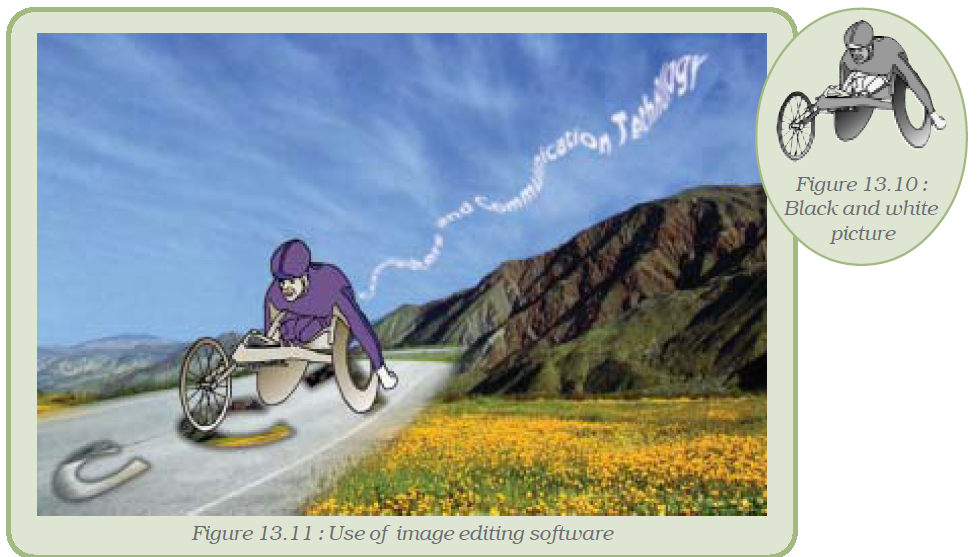
Video editing software provides facility to import and export video, cut and paste a portion of a video clip, add special effects and transitions; encode the video for creation of a DVD, Web video, mobile phone video and synchronise the audio with the video which accompany the video (e.g. Mobilevideo For iPod 3.6 b28, DVD to Video Converter etc.)
Digital Audio Workstation (DAW) allows us to manipulate recorded sounds, much like a word processor manipulates entered text.
Music sequencer (also MIDI sequencer) is package of software and hardware designed to create and manage electronic music. Sequencer these days is synonymous with software but some hardware synthesizers and almost all music workstations include a built-in MIDI sequencer. Way back the music sequencers did not have the ability to record audio, they only managed “remote-control” information (such as “note on” and “note off” events) and sent to electronic musical instruments to produce the audio output. Now a days sequencers also feature audio editing and processing capabilities. Building Blocks, Space Toad MIDI Sequencer 1.1.4 are Music sequencers.
Diagramming software are used to produce graphical diagrams such as a flowchart,circuit diagram, network diagrams, technical drawings, tools etc. They allow the users to express the information in the form of a diagram. Diagram Designer 1.21, EDraw Max, SmartDraw, Dia (GPL license), OmniGraffle, Microsoft Visio, Inspiration, Concept Draw 7 are examples of Diagramming software. The flowchart in Figure 13.12 has been made using Diagram Designer which is a Diagramming software.
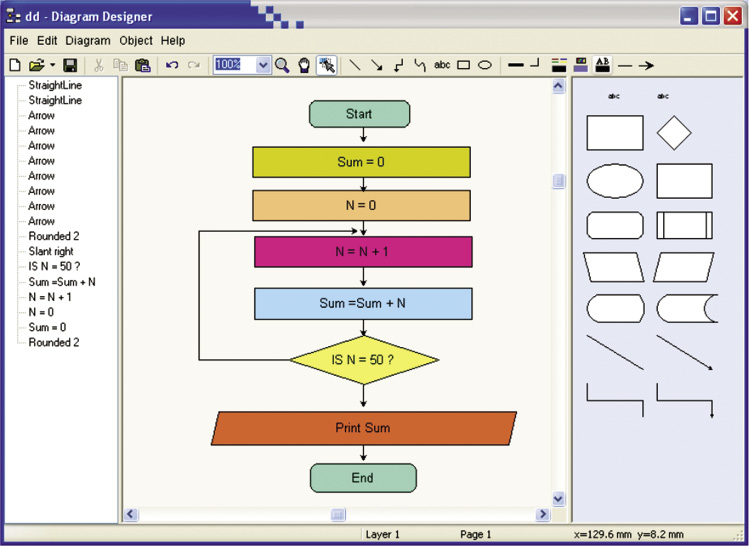
Figure 13.12 : Flowchart prepared using Diagram Designer
Computer Aided Design (CAD) software are used to create two and three-dimensional architectural design. Architects and designers usually make use of it in drafting and designing bridges, buildings, etc. and have been found to be very useful as instead of redrawing the whole plan one can modify or redraw with just a few clicks of mouse. Autodesk Streamline, AutoCAD, DWGcolumn are a few such software. Use of CAD
- saves time in making and editing the drawings
- enables the designers to lay out and develop work on the screen
- provides print out of the designs
- reduces the design cycle and over all product development costs
- stores the designs for future purposes in digital form thus occupying practically no space.
Simulation software simulates physical or abstract systems for learning, research, training or entertainment purposes. The Social simulators are used for learning the managing of socio economic aspects (e.g., crisis management, cooperation, competition, markets, social network dynamics, etc.). Battlefield simulators are used as war games, they work on theories of warfare. Training is done without the actual hostilities. Since the scope of war is not limited to military only but also political and social too, many governments make use of simulation, to test and refine their military and political policies.
The Flight simulators are mainly used for training of pilots by providing them varying degrees of realism. These are video games or full-size cockpit replicas mounted on hydraulic (or electromechanical) systems, controlled by the computer technology. The advantage is that training can be done in risk free situation. ORBITER is a free flight simulator that goes beyond the confines of Earth’s atmosphere. The Scientific simulators present data to users in pictorial forms based on some model; which enhances the understanding of relationship among the variables/data being presented. Certain important results are derived.
Office Automation and Process Management Software
There are software designed to streamline and automate different types of work processes. In commercial and business environment a single software can process loan, mortgage, insurance, claim processing, etc. The software can automate office routine, administrative processes. Accounting software e.g. Tally, GnuCash, Turbocash, are used to record and process financial transactions within functional modules such as accounts payable, accounts receivable, payroll and trial balance in a company. In short one can keep track of the expenses, purchases and incomes etc.
Tax preparation software guides us to calculate taxes and fill out tax returns and thus saves us from the complex procedure of calculations.
A transportation software is used in logistics, trucking, supply chain, and automating dispatching, operations and financial systems within an organisation.
Control and Analysis Software
There are software which control the devices by presenting data in the desired format like images or chart etc. Some of the softwares coming under this category are:
- Medical software
- Mapping software
Medical software
It is a significant branch of software engineering. Many medical devices which are in use today to control or monitor patients are predominantly controlled by software. Given below are types of medical software :
- Monitors interpreters : use software to interpret the data recorded by sensor about the heart rate, blood pressure, breathing rate of patient and display it in a desired way on the monitor.
- Medication pumps interpreters: With the help of software, these devices are programmed to pump at a certain rate, desired amount of blood, saline solution, medication etc. to the patient.
- Analysis software : Many devices, such as CAT scanners, measure raw data that a common man cannot interpret. The analysis Software creates images by reinterpreting this data that the doctors can read and understand.
- Medical Informatics : It is concerned with the business and informational aspect of medicines.
Mapping software
They are also called as Geographic Information System (GIS). They make use of combination of capabilities of programs like database management, graphics and spreadsheet etc. for displaying data graphically, in tabular form, map etc. One can see various data and its patterns and relationships among the data w.r.t. geographical locations. Based on these presentations certain important political, social, educational decisions and predictions (e.g. weather, markets, etc.) can be done which can be useful to farmers, fishermen, professionals, corporates, politicians etc.. Earthquake 3D, ArcGis, GeoNetwork OpenSource, Key Indicator Data System (KIDS) etc. are some examples. The map (Figure 13.13) showing Teacher pupil ratio at primary stage 2002 has been prepared using Geo Media Professional 4.
Pupil Teacher Ratio in Upper Primary Schools, 2002

13.6 NANOTECHNOLOGY
Nanotechnology is a technology for building or constructing materials, devices, tools etc. in smallest or lowest possible form i.e. on the scale of atom and molecule. One nanometre is a one billionth of a meter.
Nanotechnological inventions would bring enormous benefits and luxury in human life. It is widely believed that nanotechnology has got the much needed potential to be effective in terms of energy consumption besides being environment friendly. It is also expected to solve major health problems. Applications of this technology will help manufacturing products at reduced cost which will be smaller, lighter and cheaper.
The Nanotechnology is believed to be very promising in bringing solutions in the fields of health and sanitation, food security and environmental issues.
Summary
- Improvements in Hard disk drive performance have resulted from faster data rates, faster seek times, larger cache sizes, higher interface speeds, advances in microcode algorithms and most importantly higher spindle speed.
- Emerging trends in Hard Disk Drives include Enterprise HDDs, Hybrid HDDs, Full Disk Encryption (FDE) and Micro Electro Mechanical Systems (MEMS).
- Enterprise HDDs are specifically designed for mission-critical applications such as core servers and large-scale storage systems.
- A Hybrid Hard Disk Drive combines a conventional HDD and non-volatile flash memory.
- Full Disk Encryption (FDE) is a technology where data is encrypted before storage.
- MEMS-based storage has attractive features such as small size, shock resistance, and low-power consumption.
- Redundant Array of Inexpensive Disks (RAID) is used to store the same data at different places redundantly on multiple hard disks.
- Network storage like SAN and NAS allows consolidation of data spread over various parts of the organisation and reduces duplication of information.
- Online storage options provide viable storage solutions through normal Internet connections for small size companies.
- Using 3D optical data storage technology, data is stored in multiple layers in the optical disc.
- Holographic storage system is an emerging technology where data is stored through full depth of the media instead of only on the surface.
- Universal Serial Bus (USB) has become the technology of choice for connecting peripherals to PCs, cell phones, printers etc.
- Wireless USB allows connectivity to low speed devices at reasonable cost.
- Architecture of the microprocessor has changed from single processor to embedded computing devices where multiple microchips and processors are combined to form a package to meet system requirements.
- Research for developing new materials to design semiconductors which are compact, fast and energy efficient are going on.
- Optical communication system makes use of devices for maximum utilisation of the Optical backbone.
- Development in the field of wireless technology has led to more reliable, higher bandwidth and spectrum efficient devices.
- Open Source software are freely available and can be edited and customised by anyone.
- Software development has become more systematic with great emphasis on requirement engineering, prototyping and testing.
- An important trend in software is the use of component driven software development where software developers can select components from comprehensive libraries of reliable and well-documented software and combine them together to carry out the required purpose without creating everything from scratch again and again.
- Computer-aided design (CAD) programs are used to create two and three-dimensional architectural drawings, engineering drawings, and product designs. Computer Aided Manufacturing (CAM) systems use CAD to help manufacture the products.
- Mapping software combines capabilities of graphics, database management, and spreadsheet to display the data geographically which gives better understanding of geographical patterns behind the data.
- With Photo image editors you can manipulate and revise photos and other images that you have scanned with an optical scanner.
- Nanotechnology is the new field for developing material, devices, tools etc. in the smallest possible form on the scale of atoms and molecules.
EXERCISES
SHORT ANSWER TYPE QUESTIONS
1. Give any two examples of dual core processors.
2. Describe the characteristics of Xeon processors.
3. Differentiate between 3-D optical and holographic memories.
4. What is Nanotechnology?
5. What is component driven software development?
6. How Graphene is expected to improve the computer processing speed?
LONG ANSWER TYPE QUESTIONS
1. What is a processor? Describe different types of processors.
2. What are the new technologies used in processors?
3. Which different physical characteristics do a MEMS-based storage has as compared to a traditional disk?
4. Describe how binary data is stored and represented in 3-D optical storage devices.
5. What is network storage? Describe various upcoming network storage trends.
6. Mention the roles software play in our daily life. Describe with examples.
7. Describe the advantages of using a mapping software.
8. Compare educational software and computer game software.
9. Categorise different application software according to their use and give examples for each.
Activities
1. Make a comparative chart of different types of processors.
2. Find out and compare the data transfer speeds of the various data storage devices that you use like hard disks, CDs, DVDs, flash disks and others.
3. Take any unusable/malfunctioning CD and DVD and study their cross-sectional view. Observe and compare the functionalities of the different layers contained in them.
4. For each of the emerging data storage device that you have studied find out the status of its commercial production the company and the device that has been launched or is yet to be launched.
5. Find out if some organisation or institute that is accessible to you uses a network storage setup and study it.
REFERENCES
Books
Emerging Web Services Technology by Cesare Pautasso and Christoph Bussler, Publisher: Birkhause Verlag, P.O. Box 133, CH -4010 Basel, Switzerland
URLs
1. www.wikipedia.org
2. www.intel.com
3. www.amd.com
4. www.cyrix.com
5. www.research.ibm.com
6. www.ieeexplore.ieee.org
7. www.articlesbase.com
8. www.science.nasa.gov
9. www.experts-exchange.com
10. www.ietcom.oxfordjournals.org
11. www.crnano.org
12. www.webopedia.com